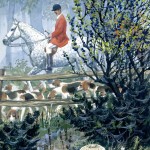The official opening date is this coming weekend but the exhibition is now more or less in place. Here is a little background to the selection of just a handful of objects that we chose to use.
In the course of planning this exhibition, my co-curator Neil Cocks and I decided it would be useful to undertake a brief review of some of the hunting-related content housed at MERL such that we could select suitable items for display. This process threw up some interesting gaps in the holdings of this (ordinarily very comprehensive) rural collection and led to the discovery of some rather unexpected connections.
We were surprised to learn, for example, that the Museum had no hunting pinks (or pinques) in its possession, this being the type of red coat traditionally worn by many in the hunting fraternity. Luckily, this did not prove a major stumbling block as I knew that my parents had in their possession a coat of this kind that was made in the nineteenth century for my Great Great Great Grandfather Charles Garfit and, as such, I decided to borrow this item for the exhibition. Thanks to Tim and Jane Douglas (a.k.a. mum and dad) for the generous loan of this coat.

The red coat made in circa 1832 for MERL curator Ollie Douglas’ ancestor Charles Garfit.
Some months prior to this I had already managed to secure a hunting whip for the collection, which I purchased at auction as part of the Museum’s ongoing project Collecting 20th Century Rural Cultures. As I waited to bid for this item I chatted at length to Mary Riall, Chief Executive of Ufton Court Educational Trust, who was there seeking artefacts for use in hands-on learning contexts. She revealed her own familial connections to hunting and the fact that, much like my parents, she too had some unused hunting paraphernalia at home. Again, this connection proved rather timely and Mary has kindly lent some boots and a riding cap for use in the exhibition. I would like to also extend my thanks to her for agreeing to this loan.

This hunting whip was acquired at an auction in Reading through Collecting Cultures funding (MERL 2011/7).
Just before Neil and I met to look over the MERL objects and to examine the coat that I had borrowed from my parents I spent some time looking at each item more carefully and reading through the related documentation. Prior to this moment I knew very little about the branch of my family to which the pinks were connected. I was therefore surprised and pleased to learn that the first owner of this coat had himself been based at Tabley House, Cheshire, a large property situated in the very county where Charles Tunnicliffe himself was to be born decades later. Ideal I thought, a Cheshire hunting artefact to help elucidate and interpret an image of a huntsman that itself almost certainly harked back to the artist’s own Cheshire roots.

This handwritten label was in the box in which the hunting coat had long been stored. It revealed the provenance of the artefact, which had previously been unknown to me.
However, this was not the end of the surprises that I had in store. As I proceeded to revisit and re-examine the hunting whip, then still quite recently purchased, I was amazed to discover that the silver ferrule on this stylised accessory was inscribed as follows:
‘J. L–W // Tabley House // Cheshire // 1928’
In a remarkable coincidence I had purchased an object for inclusion in the MERL collection that was linked by its own object biography to a house that had earlier connections to my own familial heritage. Neil and I agreed that the Cheshire connections alone were sufficient to justify incorporating these intriguing objects and that the link between them, which was also centred on the importance of ‘place’ in interpreting material culture, simply served to enhance the valuable part they could play in the exhibition. Plus, of course, the hunting pinks looked visually striking!
The importance of A Sense of Place in understanding the history of these objects, as well as the impetus and inspiration behind Tunnicliffe’s huntsman image, is clear. This area oif exploration is the subject of another project currently underway at the Museum, and about which my colleagues and I have also been blogging. If you are interested then why not check out this ongoing discussion or pay a visit to the exhibition and take a look at the whip and jacket on display.

The engraved ferrule on the hunting whip, which reveals a link to Tabley House, Cheshire.

Objects on display in the exhibition, including the red coat, as used to provide an artefactual understanding of the huntsman image.












